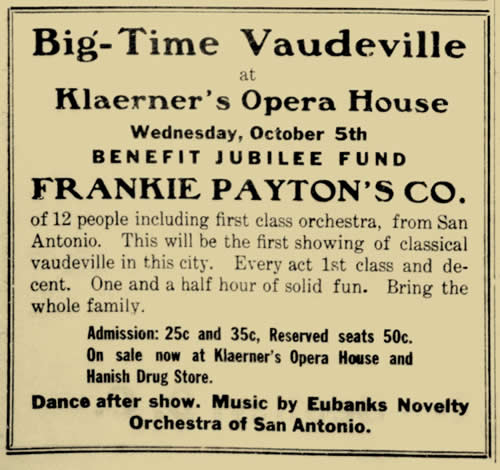Books by
Michael Barr
Order Here: |
|
Mr.
and Mrs. Poole were an ordinary couple from Illinois except that every
night before a cheering crowd she threw knives at his head, and he
shot pieces of chalk from her ears. Their vaudeville routine followed
a troupe of one-legged acrobats and a pair of boxing monkeys.
Vaudeville was a fast-paced variety show featuring a series of live
acts. It was a popular form of entertainment in America in the late
19th and early 20th centuries, especially in cities. Many rural folk
were reluctant to accept Vaudeville at first.
The word Vaudeville is French and may be a mispronunciation of the
term "Vau-de-Vire," an area of northern France known for its bawdy
drinking songs. It was those French origins that made many rural Texas
suspicious of it.
The French had a reputation for immodesty. To Texans even polite French
words sounded naughty.
To make matters worse, some people confused Vaudeville with Burlesque
which was a more provocative style of adult entertainment, often with
sexual overtones. Burlesque, from an Italian word meaning to joke,
mock or ridicule, was Vaudeville's dirty little brother.
For these and other reasons, Vaudeville didn't always have the best
reputation, especially in the more conservative parts of the country.
In 1884 a San Antonio
newspaper described the city's Vaudeville dens as "a blot on civilization,"
especially after assassins killed gunfighters Ben Thompson and King
Fisher in a wild shootout at Jack Harris's Vaudeville Theater, "a
vile place fronting San Antonio's Main Plaza."
Vaudeville even had a less than sterling reputation in show business
circles. Serious thespians coined the term "legitimate theater" to
separate themselves from the low-class beerhall singers, can-can dancers
and medicine show barkers who were the original Vaudeville performers.
But once Vaudeville caught on in the countryside, people couldn't
get enough of it. |
 |
Vaudeville
at Klaerner's Opera House
Courtesy
of Fredericksburg Standard |
Klaerner's
Opera House, Peter's Hall and The
Palace Theater in Fredericksburg
hosted regular vaudeville shows. So did the Arcadia Theater and Pampell's
Opera House in Kerrville.
Other shows performed in tents. In January 1923 the Grandi Brothers
Stock Company came to Fredericksburg,
set up a tent at Marktplatz and stayed a week. Ads claimed the tent
was "double walled, as warm and cozy as your living room and absolutely
water-proof."
Cost for a ticket was 40 cents for adults and 10 cents for children.
Knowing the conservative nature of rural Texas communities, managers
were careful to stage shows that were "strictly clean and moral."
The style came to be called "polite Vaudeville."
At the same time theater managers carefully screened new acts. They
sent "impolite" scripts back to actors in blue envelopes, leading
to the phrase "blue material," a reference to content that was too
hot to handle.
It was interesting to note that just about every act that passed through
the Hill Country
in those days had "recently returned from a tour of Europe where the
cast entertained the crowned heads of state." Singers and dancers
were "fresh from the Broadway stage."
Of course there was no way to check the validity of those claims.
The internet hadn't been invented yet.
The typical "polite" Vaudeville show featured singers, dancers and
comedians in addition to all kinds of interesting specialty acts.
An early Vaudeville show at Peter's Hall
in Fredericksburg
starred Baby Edna, world's champion child buck and wing dancer.
Another show featured Lady Pat, a horse who could add, subtract, multiply
and divide. Lady Pat could tell time. She could pick out the flags
of different countries.
Some Vaudeville shows staged boxing and wrestling matches. Dancers
performed serpentine dancing, also called skirt dancing, a toned down
version of the can-can. Monologists recited Shakespeare and "Casey
at the Bat."
But there was trouble ahead for Vaudeville. Radio hurt ticket sales
in the 1920s. Then an exciting new form of entertainment knocked Vaudeville
for a loop.
In 1927 talking pictures took the country by storm. By 1935 most Vaudeville
theaters converted to movie houses and the top talent left Vaudeville
for radio and Hollywood.
But in its day Vaudeville was the theater of the people. It had something
for everybody. It was the most democratic art form in American history.
|
|
|
